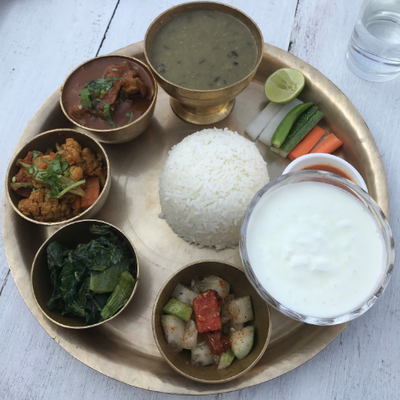Food
Some things just don’t mix
Yum Yum Cafe in Jhamsikhel is one of the latest restaurants on the block, but how does it fare compared to the rest of the pan-Asian fare?
Hantakali
Fusion is a funny word, exciting by inciting ideas of groundbreaking food combinations that have never been done before. It’s a word that has been demonised in the food world too, coined in the 80s and, later, becoming a warning sign for contrived and busy food. But that word, despite what its connotations might be elsewhere in the world, has been blazoned on Yum Yum Cafe’s signage.
From the outside, this restaurant comes off twee. The bright signage, the childish font and cutesy connotation of the phrase “yum yum” all set it up to seem like a family restaurant where serious food isn’t served. The interior, however, is a nice mixture of softer colours and pale wooden tones, retaining a saccharin slant while displaying a level of maturity. Bamboo umbrellas hang from the ceiling, pastel walls feature crockery and prints, and the cedar-tone bar is adorned with cherry blossoms. There’s a trickling fountain in the corner and more intimate seating outback. The space is a fusion of contemporary, cute and comfortable, and shows a level of care and consideration.
Despite the restaurant’s fishbowl front, with floor to ceiling windows, the space is relatively quiet and diners seem to be eating in peace once we arrive. Once we are seated, the server delivers the menus and flutters away quietly to leave us to peruse what offerings the restaurant has—and it has a lot.
This restaurant’s fusion seems firmly based on Chinese and Japanese cuisines, and other cuisines influences are introduced from there. Among the obviously spliced dishes are shumai, with chicken and basil or prawns and yellow curry; bao, with chicken, Korean sauce and nori; pizza, but apparently in Japanese style; and various wok- and stone pot-borne dishes.
Taking a smattering of dishes from the menu, and anticipating an uncomfortable stuffing, the dishes start to come out rather quickly. During the wait, the lurid ramekins attract the eye. There’s hoisin, chili oil, a peanut sauce, and a few others, along with salt, pepper and a bottle of soy. It seems here that they are covering their bases, and leaving some of the fusion up to the diner.
With the first bite coming in the form of Cantonese dumplings—a very broad term—these sauces are simply too much. Even soy might overpower these subdued, mild morsels, filled with beans, water chestnut, corn and carrot. The dumplings are best eaten unsullied, to show off their demure flavours. Unlike vegetable momos, which are almost keema-like in texture, the filling of this dumpling retains textural variety. The water chestnut gives its aqueous nuttiness, while the beans gush under tooth, and there’s a vague sweetness coming from the rest of its constitution. Their translucent housing does enough to contain the filling, but doesn’t protest when broken into. It’s a promising start, but the portion-to-price is a slight warning for the rest of the meal.

Looking a few pages further into the menu, one will find the “Kathmandu roll”. It’s hard to know what exactly Kathmandu is about, but its name alone justifies a taste. Apparently filled with jalapeños, onion, coriander, tomato, kimchi mayonnaise, it’s actually the blushing tuna that catches the eye. With a shard of fried garlic atop a droplet of kimchi mayonnaise anointing the tuna-laden rolls, it’s an attractive dish. It’s also rather satisfying, with a hint of spicy funk from the mayo and necessary textural variety from the garlic. There’s the obligatory blodge of wasabi and pyre of pink pickled ginger, but this sushi is presauced and probably doesn’t need much other than a quick soy dip.
But if sushi always comes in some familiar form, and dumplings are relatively self-explanatory, then what in the world is Japanese pizza? Japan has some great pies—there are several Neapolitan pizza places that have found fame—but what the server tells us is that the topping is raw. Its foundation is cooked, so the mind goes straight to crusty-cornered, pillowy soft bread. But what came out was a shock, to say the least—carpaccio avocado, sliced thin and arranged into a floret pattern, dusted with togarashi chili seasoning. The base of the pizza seems to be something like a fried wonton wrapper, and between that and the avocado is some spicy mayonnaise. It tastes OK, but it honestly feels less like a pizza and more like a tostada, which hails from Latin America. The difference with tostadas, however, is they are crispy, while this Japanese pizza is brittle and requires quick plate-mouth transferral. The flavours are fine, if you like avocado and spice, but the disappointment is sour.
What comes out next does enough to excite away the pizza’s bitter aftertaste. Arriving on a throne, like tacos might, pork bao's braised shades of pork topped with hoisin are enough to arrest one's attention. Sprinkled with peanuts and dripping sauce, the pork looks like an enticing mess. The textural contrast provided by the peanuts saves the dish, because the cucumber has lost its sturdiness under the weight of the pork and sauce. The meat itself is close to right, but it’s just a bit closer to tough. The syrupy sauce with fatty pork is satisfying, with some spicy addition, perhaps for what the restaurant perceives Nepalis desire. The tingmo-style bread the meat is sandwiched in is pillowy soft and an unobtrusive vessel for the overall supple dish.
The final dish we try is simply called Thai style basil chicken, which comes out steaming in a covered bowl, with another bowl of sticky rice. The smell is rather enticing, with a resounding whiff of fish sauce, but the typical pungence of Thai holy basil doesn’t seem to be there. The chicken, sliced into thin slabs, is glazed with the mixture of oyster and soy sauce and dotted with sliced chilli, but the probable addition of fish sauce is slightly overpowering. The sweet element is also slight, but the biggest problem is that the basil doesn’t shine through. It seems to have wilted down too much to donate its full flavour. The sticky rice is a little dry too, which simply isn’t good enough considering it goes for a jaw-dropping Rs 285 per bowl.
What does work in Yum Yum Cafe’s favour, however, is the fact that its entering into a field of cuisine that seems to underachieve on most fronts. While the restaurant certainly has promise, it does fall flat in many ways, when it comes to food. But it's competing against not-so-thought-out restaurants that are quick to label themselves pan-Asian or fusion, without really paying heed to how they’ll please the palate.
Yum Yum Cafe’s interior is great, it’s vibe impressive, and parts of the cuisine is done quite well, but the biggest thing it will come up against is a price sensitive market. While the food’s not too overwrought, the cost-per-plate is just too high. Of course, the restaurant might say it imports a lot of its food, and that’s OK, but perhaps there are more cost-effective ways of delivering fusion to Kathmandu.




 9.12°C Kathmandu
9.12°C Kathmandu











